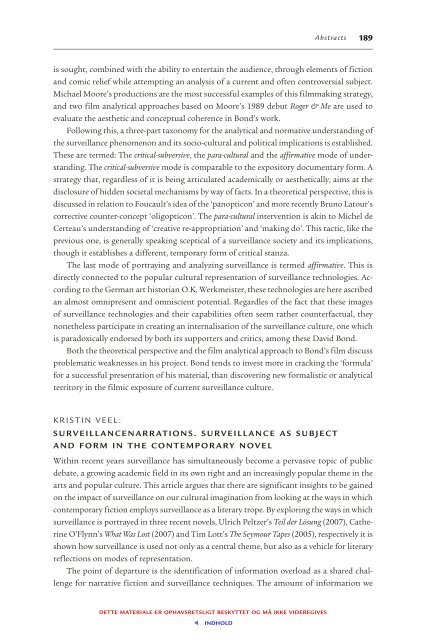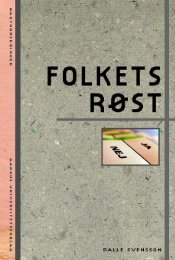K&K. Kultur og Klasse · Nr. 110 · Årgang 2010 - Aarhus University ...
K&K. Kultur og Klasse · Nr. 110 · Årgang 2010 - Aarhus University ...
K&K. Kultur og Klasse · Nr. 110 · Årgang 2010 - Aarhus University ...
Create successful ePaper yourself
Turn your PDF publications into a flip-book with our unique Google optimized e-Paper software.
DETTE MATERIALE ER OPHAVSRETSLIGT BESKYTTET OG MÅ IKKE VIDEREGIVES<br />
INDHOLD<br />
Abstracts<br />
is sought, combined with the ability to entertain the audience, through elements of fiction<br />
and comic relief while attempting an analysis of a current and often controversial subject.<br />
Michael Moore’s productions are the most successful examples of this filmmaking strategy,<br />
and two film analytical approaches based on Moore’s 1989 debut R<strong>og</strong>er & Me are used to<br />
evaluate the aesthetic and conceptual coherence in Bond’s work.<br />
Following this, a three-part taxonomy for the analytical and normative understanding of<br />
the surveillance phenomenon and its socio-cultural and political implications is established.<br />
These are termed: The critical-subversive, the para-cultural and the affirmative mode of understanding.<br />
The critical-subversive mode is comparable to the expository documentary form. A<br />
strategy that, regardless of it is being articulated academically or aesthetically, aims at the<br />
disclosure of hidden societal mechanisms by way of facts. In a theoretical perspective, this is<br />
discussed in relation to Foucault’s idea of the ‘panopticon’ and more recently Bruno Latour’s<br />
corrective counter-concept ‘oligopticon’. The para-cultural intervention is akin to Michel de<br />
Certeau’s understanding of ‘creative re-appropriation’ and ‘making do’. This tactic, like the<br />
previous one, is generally speaking sceptical of a surveillance society and its implications,<br />
though it establishes a different, temporary form of critical stanza.<br />
The last mode of portraying and analyzing surveillance is termed affirmative. This is<br />
directly connected to the popular cultural representation of surveillance tech nol<strong>og</strong>ies. According<br />
to the German art historian O.K. Werkmeister, these tech nol<strong>og</strong>ies are here ascribed<br />
an almost omnipresent and omniscient potential. Regardles of the fact that these images<br />
of surveillance tech nol<strong>og</strong>ies and their capabilities often seem rather counterfactual, they<br />
nonetheless participate in creating an internalisation of the surveillance culture, one which<br />
is paradoxically endorsed by both its supporters and critics, among these David Bond.<br />
Both the theoretical perspective and the film analytical approach to Bond’s film discuss<br />
problematic weaknesses in his project. Bond tends to invest more in cracking the ‘formula’<br />
for a successful presentation of his material, than discovering new formalistic or analytical<br />
territory in the filmic exposure of current surveillance culture.<br />
KRISTIN VEEL:<br />
SURVEILLANCENARRATIONS. SURVEILLANCE AS SUBJECT<br />
AND FORM IN THE CONTEMPORARY NOVEL<br />
Within recent years surveillance has simultaneously become a pervasive topic of public<br />
debate, a growing academic field in its own right and an increasingly popular theme in the<br />
arts and popular culture. This article argues that there are significant insights to be gained<br />
on the impact of surveillance on our cultural imagination from looking at the ways in which<br />
contemporary fiction employs surveillance as a literary trope. By exploring the ways in which<br />
surveillance is portrayed in three recent novels, Ulrich Peltzer’s Teil der Lösung (2007), Catherine<br />
O’Flynn’s What Was Lost (2007) and Tim Lott’s The Seymour Tapes (2005), respectively it is<br />
shown how surveillance is used not only as a central theme, but also as a vehicle for literary<br />
reflections on modes of representation.<br />
The point of departure is the identification of information overload as a shared challenge<br />
for narrative fiction and surveillance tech niques. The amount of information we<br />
189








